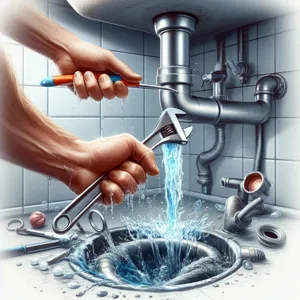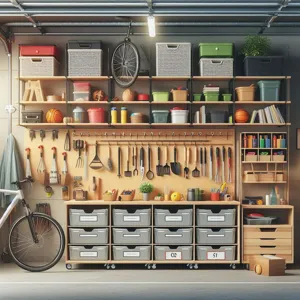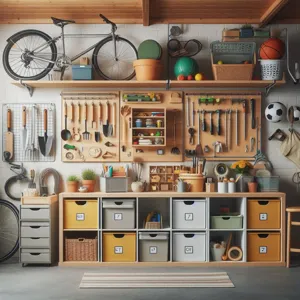The entryway is the unsung hero of any home, serving as the first impression for guests and a personal sanctuary for daily comings and goings.
It sets the tone for the rest of your space, blending functionality and aesthetics into a seamless introduction to your living environment. However, many of us overlook this pivotal area, leaving it cluttered or uninspired. In this ultimate guide, we’ll explore transformative ideas that will elevate your entryway from mundane to magnificent. From clever storage solutions and stunning decor to lighting options that create an inviting ambiance, we’ll provide you with practical tips and creative inspiration to craft a welcoming entryway that reflects your style and makes a lasting impression. Get ready to roll up your sleeves and reinvent this essential space into one that greets you and your visitors with warmth and charm!
1. Understanding the Importance of an Entryway

The entryway is the first impression your home makes on guests, and it often sets the tone for their entire visit. It’s more than just a passage; it’s a transition space that welcomes people into your sanctuary. Understanding the importance of an entryway goes beyond aesthetics—it encompasses functionality, organization, and the emotional warmth that a well-designed entry can evoke.
When you step through the front door, what do you want your guests to feel? A cluttered or disorganized entry can create a sense of chaos, while a thoughtfully arranged space invites a sense of calm and hospitality. It’s in this area that you can express your personal style, showcasing decor that reflects your personality while simultaneously creating a warm atmosphere. From a chic console table adorned with family photos to a vibrant piece of artwork that sparks conversation, every element can contribute to a welcoming vibe.
Moreover, a well-organized entryway enhances the functionality of your home. It serves as a practical hub where you can manage the daily influx of items—shoes, bags, keys, and coats. By incorporating smart storage solutions such as hooks, baskets, and benches, you can keep this space tidy and efficient. This organization not only makes life easier but also ensures that your home remains a serene refuge from the outside world.
In essence, a thoughtfully designed entryway is key to creating an inviting atmosphere. It’s the first space your family and visitors encounter, and it should embody the warmth, style, and functionality that defines your home. As we explore how to transform this area, remember that every choice you make contributes to the overall impression your home leaves on those who enter. Let’s dive deeper into the elements that will elevate your entryway from mundane to magnificent!
2. Assessing Your Current Entryway: Key Considerations
Before diving into the exciting world of design and decor, it’s crucial to take a step back and assess your current entryway. This foundational step will not only help you understand the space you’re working with but also guide your transformation efforts in a way that reflects your personal style and meets your functional needs. Here are some key considerations to keep in mind during your assessment:
**Size and Layout**: Begin by measuring your entryway. Is it spacious or more compact? Understanding the dimensions will help you determine what types of furniture and decor will fit comfortably without creating a cluttered feel. Consider the layout: are there any existing architectural features like stairs, doors, or windows that you need to work around?
**Lighting**: Evaluate the natural light that enters your entryway throughout the day. A well-lit space can feel more inviting, while a dimly lit area may need additional light sources. Consider the placement of existing light fixtures and think about whether you need to add wall sconces, a stylish pendant, or even a console table with a lamp to brighten up the space.
**Functionality**: Reflect on how you currently use your entryway. Is it primarily a passageway, or does it serve additional purposes, like a drop zone for keys and bags? Identifying the functions your entryway needs to fulfill will help you select appropriate storage solutions, such as hooks for coats, a bench for seating, or baskets for shoes.
**Style and Aesthetic**: Take note of the existing colors, textures, and styles in your entryway. Is it aligned with the rest of your home, or does it feel disconnected? Consider what kind of atmosphere you want to create—should it be modern and sleek, warm and rustic, or colorful and eclectic? This will influence your choices in paint, flooring, and decor.
**Traffic Flow**: Observe how people move through your entryway. Is there enough space for everyone to come and go without bumping into furniture or each other? Ensuring a smooth traffic flow is essential for a welcoming space. Think about how you can rearrange or remove elements to enhance accessibility.
By taking the time to assess these aspects of your current entryway, you’ll be better equipped to create a welcoming and functional space that not only complements your home but also makes every arrival feel special. With a clear understanding of your starting point, you can confidently move forward with your design plans, ensuring a transformation that is both practical and aesthetically pleasing.
3. Defining Your Entryway Style: Modern, Traditional, or Eclectic

Defining your entryway style is a crucial step in creating a welcoming atmosphere that reflects your personality and sets the tone for the rest of your home. The entryway is often the first impression guests have of your space, so whether you lean towards modern, traditional, or eclectic, choosing a cohesive style will enhance the overall aesthetic and functionality.
**Modern Entryway**: If clean lines and minimalist designs appeal to you, a modern entryway might be the perfect fit. Think sleek furnishings, neutral color palettes, and metallic accents. Consider a geometric console table paired with a simple mirror to create an illusion of space and light. To add warmth, incorporate natural elements, such as a potted plant or a textured rug. With modern style, less is often more, so aim for a clutter-free zone that prioritizes functionality while maintaining a sense of sophistication.
**Traditional Entryway**: For those who cherish classic elegance, a traditional entryway can evoke a sense of timeless charm. rich woods, ornate details, and classic color schemes are hallmarks of this style. An antique hall tree or a beautifully upholstered bench can serve as a focal point, providing both seating and storage. Layering your space with vintage-inspired decor, such as framed artwork or a decorative mirror, will create a warm and inviting feel. soft lighting from a chandelier or wall sconces can enhance the atmosphere, enveloping your guests in a cozy embrace as soon as they step through the door.
**Eclectic Entryway**: If you’re someone who loves to mix and match different styles, an eclectic entryway is your canvas. This style allows for creativity and personal expression, blending various textures, colors, and patterns. Consider combining a bold, patterned wallpaper with an array of unique artwork that reflects your travels or hobbies. A vintage rug can add warmth, while mismatched furniture pieces can create an inviting, lived-in feel. Don’t shy away from layering textures—think about incorporating items like woven baskets, metal accents, and soft textiles to create a dynamic entryway that invites conversation and inspires curiosity.
In defining your entryway style, consider not just aesthetics but also how the space will function for you and your guests. By aligning your entryway with your personal taste and lifestyle, you’ll create a welcoming atmosphere that serves as a beautiful introduction to your home.
4. Essential Elements of a Welcoming Entryway
A welcoming entryway sets the tone for your entire home, creating an inviting atmosphere that makes guests feel instantly at ease. To achieve this, consider incorporating several essential elements that work harmoniously to enhance both functionality and aesthetics.
**1. A Statement Door:** Begin with your front door—it’s the first impression guests have of your home. Opt for a door that reflects your personal style, whether it’s a bold color that stands out in your neighborhood or a classic wooden finish that exudes warmth. Don’t forget to adorn it with a beautiful wreath or seasonal decorations to add a personal touch.
**2. Thoughtful Lighting:** Good lighting is crucial in an entryway. Consider layering your lighting with a combination of overhead fixtures, sconces, and table lamps to create a warm glow that welcomes visitors. A stylish pendant light or chandelier not only illuminates the space but also acts as a focal point that enhances your entryway’s character.
**3. Functional Furniture:** Incorporate practical pieces that serve a purpose while enhancing the visual appeal. A console table can provide a spot for keys and mail, while a bench or a set of stylish stools offers a place to sit as guests put on or take off their shoes. Choose furniture that complements your home’s decor and is proportionate to the size of your entryway.
**4. Storage Solutions:** Keep your entryway clutter-free with smart storage solutions. A decorative basket or a stylish coat rack can help manage outerwear and accessories, while built-in shelves or cabinets can provide additional space for shoes and bags. This not only maintains a tidy appearance but also ensures that your entryway remains functional and organized.
**5. Personal Touches:** Finally, add elements that reflect your personality and make the space truly yours. Family photos, artwork, or a curated collection of travel souvenirs can personalize your entryway and create a warm, inviting atmosphere that tells your story. Incorporating plants or fresh flowers can also breathe life into the space, bringing a touch of nature indoors.
By thoughtfully combining these essential elements, you can transform your entryway into a welcoming space that leaves a lasting impression on all who visit. Whether your style is modern, traditional, or eclectic, these tips will help you create an entryway that beautifully reflects your home and invites everyone in with open arms.
5. Color Palette and Lighting: Setting the Mood

When it comes to transforming your entryway, the color palette and lighting play a pivotal role in setting the mood and creating a lasting first impression. The entryway is the threshold to your home, a space that should immediately convey warmth and style while reflecting your personal taste.
Choosing the right colors can evoke different emotions and set the stage for the rest of your home. Soft, neutral tones—like warm whites, soft grays, or muted earth tones—offer a serene and inviting atmosphere, making the space feel open and airy. Alternatively, bolder hues such as deep blues or rich greens can create a striking focal point, exuding confidence and sophistication. Consider incorporating accent walls or decorative elements in these colors to add depth and interest without overwhelming the space.
Lighting is equally essential in crafting the ideal ambiance. A well-lit entryway is not only practical but also welcoming. Natural light is your best friend, so if your entryway has windows, be sure to maximize that brightness. For spaces lacking natural light, opt for layered lighting solutions that include overhead fixtures, wall sconces, and table lamps. Choose warm-toned bulbs to create a cozy glow, and consider installing dimmers to adjust the mood according to the time of day or occasion.
To further enhance the aesthetic, think about adding lighting fixtures that double as statement pieces. A charming chandelier or a unique pendant light can draw the eye upward, making the area feel more spacious and inviting. Incorporating mirrors can also amplify light and create the illusion of a larger entryway while reflecting your carefully curated decor.
By thoughtfully selecting your color palette and lighting, you can transform your entryway into a warm and welcoming space that not only impresses guests but also sets a positive tone for the rest of your home. Remember, it’s the little details that make a big difference, so let your personality shine through as you create an inviting atmosphere that beckons everyone to step inside.
6. Choosing the Right Flooring for Your Entryway
### 6. Choosing the Right Flooring for Your Entryway
Selecting the right flooring for your entryway is a crucial step in transforming your home into a welcoming space. The entryway is the first impression guests receive, so it’s essential to choose a flooring material that is both functional and aesthetically pleasing.
When considering flooring options, durability should be at the forefront of your mind. The entryway endures heavy foot traffic, so materials like ceramic tile, luxury vinyl, or engineered hardwood are excellent choices. These options not only withstand the wear and tear but are also easy to clean, making them practical for daily use. For instance, ceramic tiles come in various styles and textures, allowing you to create a chic, polished look while remaining resilient against spills and dirt.
Additionally, think about the climate in your area. If you live in a particularly wet region, consider slip-resistant tiles or rubber flooring to enhance safety for you and your guests. On the other hand, if you want to introduce warmth and comfort, consider a high-quality area rug over a hardwood or laminate floor. The rug can add a touch of personality, color, and style while providing a cozy welcome.
Another important factor is color and design. Lighter hues can make a small entryway feel more spacious and inviting, while darker tones can add sophistication and depth. You might even opt for a bold pattern to create a statement that reflects your personal style. Remember, the entryway sets the tone for the rest of your home, so choose a flooring design that harmonizes with your overall décor.
Finally, don’t forget about maintenance. Choose materials that align with your lifestyle. If you have pets or young children, you may want to prioritize scratch-resistant and stain-resistant options. By thoughtfully selecting the flooring for your entryway, you’ll create a functional space that is not only welcoming but also a true reflection of your home’s character.
7. Functional Furniture: Benches, Hooks, and Storage Solutions

When it comes to transforming your entryway into a welcoming and functional space, the right furniture can make all the difference. Functional furniture serves a dual purpose: it enhances the aesthetic appeal of your home while providing practical solutions to everyday challenges. Consider incorporating benches, hooks, and storage solutions that not only elevate your entryway’s style but also streamline its functionality.
**Benches** are a fantastic starting point. They offer a convenient spot for putting on or taking off shoes, and they create a cozy nook that beckons guests to sit and relax for a moment. Opt for a bench with hidden storage underneath to maximize space; this can be the perfect place to stow away shoes, seasonal items, or even dog leashes, keeping clutter at bay.
**Hooks** are another essential element in a functional entryway. They provide a designated spot for coats, bags, and hats, ensuring that your entryway remains tidy. Choose decorative hooks that align with your home’s aesthetic—whether you prefer sleek modern designs or rustic, vintage-inspired pieces. For an organized look, consider a wall-mounted rack that combines hooks with a small shelf for keys or decorative items, adding both charm and utility.
**Storage solutions** are crucial for maintaining a neat and inviting atmosphere. Consider incorporating a stylish console table with drawers for storing mail and miscellaneous items, or a tall cabinet that can hide away larger items while still offering easy access. Baskets can also be a charming addition; they not only provide a practical way to keep smaller items organized, but they also add texture and warmth to the space.
By thoughtfully selecting functional furniture that meets your needs, you create an entryway that is both inviting and efficient. A well-arranged entryway sets the tone for your home, welcoming guests with open arms while keeping your family organized and ready for the day ahead. With the right pieces in place, you can effortlessly transform your entryway into a stylish and functional introduction to your home.
8. Adding Personal Touches: Artwork and Decor
When it comes to transforming your home, the entryway serves as the perfect canvas to showcase your personality and set the tone for the rest of your space. Adding personal touches through artwork and decor can elevate this often-overlooked area into a warm and inviting introduction to your home.
Consider selecting pieces that resonate with you or tell a story—whether it’s a vibrant painting that evokes fond memories of a family vacation or a print from a local artist that captures the essence of your community. These elements can serve as conversation starters and create a sense of connection to your space.
In addition to artwork, consider incorporating unique decorative items that reflect your style. A beautifully crafted console table adorned with a few curated pieces—like a vintage vase, a stack of treasured books, or a framed photograph—can create an inviting atmosphere. These small details not only enhance the visual appeal of your entryway but also make it feel more lived-in and personal.
Don’t shy away from mixing textures and materials to add depth. A combination of wood, metal, and fabric can create a layered look that feels both stylish and cozy. Throw in a soft rug or a woven basket for umbrellas and shoes, and you’ll achieve a harmonious blend of aesthetics and functionality.
Ultimately, your entryway should feel like an extension of who you are. By thoughtfully selecting artwork and decor that resonates with you, you can create an inviting space that welcomes both you and your guests every time you walk through the door.
9. Incorporating Plants and Natural Elements
Incorporating plants and natural elements into your entryway is one of the most effective ways to create a warm and inviting atmosphere. The presence of greenery not only breathes life into the space but also enhances the overall aesthetics, making it a perfect welcome for both you and your guests.
Start by selecting a few carefully chosen plants that thrive in low-light conditions, as entryways often lack direct sunlight. Consider options like snake plants, pothos, or peace lilies, which require minimal maintenance while offering vibrant foliage. These plants can be placed in stylish pots that complement your decor — think terracotta for a rustic feel, sleek ceramics for a modern touch, or woven baskets for a cozy, natural vibe.
In addition to potted plants, you can incorporate natural elements such as wood, stone, and even water features. A reclaimed wood bench can provide a functional seating area while adding warmth and character. A stone accent piece, like a small sculpture or a decorative bowl filled with smooth river stones, can serve as a beautiful focal point. If space permits, a cascading water feature can introduce soothing sounds and a sense of tranquility, making your entryway feel more like a serene retreat.
Don’t forget to play with texture and color! Layering different types of greenery alongside earthy materials can create a harmonious balance that feels both fresh and inviting. You can also consider seasonal arrangements, switching out plants or adding seasonal blooms to keep the entryway dynamic and reflective of the time of year.
By thoughtfully incorporating plants and natural elements, you’ll not only enhance the visual appeal of your entryway but also create a welcoming environment that leaves a lasting impression on all who enter your home.
10. Maximizing Space: Tips for Small Entryways
When dealing with a compact entryway, the key lies in maximizing every inch without sacrificing style. An inviting small entryway can set the tone for your entire home, and there are several creative strategies to transform this often-overlooked space into a functional and welcoming area.
**1. Opt for Multi-Functional Furniture:** Choose pieces that serve more than one purpose. A sleek bench with built-in storage can provide a place to sit while donning shoes and discreetly hide away clutter, such as bags and seasonal items. Look for slim console tables that can double as a drop zone for keys and mail, or consider wall-mounted shelves that keep surfaces clear while adding decorative touches.
**2. Utilize Vertical Space:** When square footage is limited, think vertically. Install hooks or a pegboard above the entryway bench for hanging coats, bags, and accessories. Tall shelving units can draw the eye upward, creating the illusion of more space while offering practical storage for shoes or decorative items.
**3. Embrace Mirrors:** Mirrors are a small space’s best friend. They reflect light and create a sense of depth, making your entryway feel larger and airier. A well-placed mirror not only serves as a functional item for last-minute touch-ups but also adds a stylish element to the decor.
**4. Choose Light Colors:** Light and neutral color palettes can make a small space feel open and inviting. Soft whites, light grays, or muted pastels can help brighten the entryway and give it a more expansive feel. You can add pops of color through accessories such as rugs, artwork, or potted plants to maintain interest without overwhelming the space.
**5. Keep It Clutter-Free:** A small entryway can quickly become chaotic if not managed properly. Establish a daily routine for keeping the area tidy—designate a spot for shoes, bags, and other essentials, and encourage family members to stick to it. Regular decluttering can help maintain an inviting atmosphere and ensure that your entryway remains a true welcome home.
By incorporating these tips, you can transform a small entryway into a stylish, organized, and functional space that greets both you and your guests with warmth and charm. Whether through clever use of furniture, strategic color choices, or smart organizing techniques, maximizing your entryway can set the stage for a cozy atmosphere throughout your home.
11. Seasonal Decor Ideas for a Fresh Look
Transforming your entryway with seasonal decor is a delightful way to keep your home feeling fresh and inviting throughout the year. Each season brings its own unique colors, textures, and themes that can effortlessly enhance the aesthetic of your space.
**Spring** is the perfect time to embrace vibrant hues and natural elements. Consider incorporating pastel-colored wreaths adorned with faux flowers or fresh blooms to hang on your door. A cheerful doormat featuring colorful designs can set a welcoming tone before guests even step inside. Add potted plants or small topiaries flanking your entryway for a touch of greenery that symbolizes new beginnings.
As summer rolls in, think about creating a coastal vibe. Swap out heavier decorations for light, airy pieces. Seashells in decorative bowls, nautical-themed artwork, or a simple, breezy garland made from driftwood can evoke the essence of summer. Brightly colored cushions on a nearby bench or chair can also invite guests to linger a little longer in your welcoming entryway.
Fall offers a wonderful opportunity to celebrate the changing leaves and the harvest season. Incorporate rich, warm tones like deep oranges, reds, and browns through decorative pumpkins, hay bales, or a rustic basket filled with pinecones. A cozy throw draped over a bench or a stylish rug with autumn motifs can create an inviting atmosphere, perfect for those crisp fall days.
Finally, as winter approaches, transform your entryway into a cozy retreat that captures the magic of the season. Opt for elegant decorations like twinkling fairy lights, garlands made of evergreen, or even a festive wreath adorned with berries and pinecones. A lovely, warm throw can be added to a chair, inviting guests to wrap themselves up as they step inside from the cold. With a few simple changes, your entryway can reflect the beauty of each season, making every arrival feel special and welcoming.
By embracing seasonal decor, you’ll not only enhance your home’s aesthetic but also create an entryway that resonates with the warmth and joy of each time of year.
12. Creating a Scented Welcome: Candles and Diffusers
Creating a scented welcome in your entryway is a simple yet impactful way to set the tone for your home. As soon as guests step inside, the inviting aroma can evoke feelings of warmth and comfort, making them feel instantly at ease. Candles and diffusers are not only functional but also decorative elements that can enhance the ambiance of your space.
When selecting candles, consider those with soothing fragrances like lavender, vanilla, or citrus—scents known for their calming and uplifting properties. Opt for beautifully designed candle holders that complement your entryway decor. Grouping candles of varying heights can create an elegant focal point on a console table or shelf, while the flickering flame adds a cozy glow.
Diffusers, on the other hand, offer a more subtle and continuous scent experience. Reed diffusers are an excellent choice for entryways, as they gently release fragrance over time without any flame. Choose essential oils or fragrant blends that resonate with your personal style—perhaps a refreshing eucalyptus or a warm spice blend. Place the diffuser in a strategic spot where it can be easily seen but won’t be in the way of daily activities.
To elevate the sensory experience further, consider incorporating seasonal scents. In the fall, you might lean towards pumpkin spice or apple cinnamon, while winter could introduce notes of pine or peppermint. This seasonal rotation not only keeps your entryway fresh but also creates a sense of anticipation and celebration throughout the year.
Finally, remember that less is sometimes more. A well-placed candle or a single stylish diffuser can make a statement without overwhelming the senses. By thoughtfully curating the scents in your entryway, you create an atmosphere that welcomes guests with open arms, leaving a lasting impression that invites them to linger longer in your home.
13. Maintenance Tips for a Beautiful Entryway
An inviting entryway sets the stage for the entire home, but maintaining its charm requires consistent effort and attention. Here are some essential maintenance tips to ensure your entryway remains beautiful and welcoming year-round.
**1. Regular Cleaning:** Dust, dirt, and debris can quickly accumulate, especially in high-traffic areas. Sweep or vacuum the floor regularly and wipe down surfaces like tables and shelves. Don’t forget to clean any glass elements, such as mirrors or windows, to let natural light filter through and enhance the space.
**2. Seasonal updates:** Your entryway can benefit from seasonal decor changes. Swap out decorative elements with the seasons—a wreath for the door, a new runner for the floor, or a fresh vase of seasonal flowers can make a big impact. These small updates keep the space feeling fresh and inviting.
**3. Organize Clutter:** Keep your entryway clutter-free by implementing smart storage solutions. Use baskets, bins, or stylish hooks to corral items like shoes, bags, and jackets. Regularly assess these items to ensure everything has a place, and make it a habit to remove any belongings that don’t belong in the entryway.
**4. Check Lighting:** Proper lighting is crucial for creating a warm and welcoming entryway. Regularly check and replace bulbs in overhead fixtures or wall sconces to maintain a bright atmosphere. Consider adding accent lighting, like a table lamp or decorative lanterns, to create a cozy ambiance, especially during the evening.
**5. Maintain the Floor:** Your flooring endures heavy foot traffic, so it’s essential to keep it in good shape. For hardwood floors, use a suitable cleaning product to avoid damage. If you have rugs or mats, shake them out regularly and wash them as needed to prevent them from looking worn or dirty.
**6. Refresh Paint and Finishes:** Over time, even the most carefully maintained entryway can start to look tired. Keep an eye out for scuff marks or fading paint, and consider a fresh coat every few years. Touching up finishes on furniture can also keep them looking vibrant.
**7. Assess the Functionality:** Finally, take some time to evaluate the functionality of your entryway. Is it still serving its purpose effectively? If not, consider rearranging furniture or adding new elements, such as a bench for seating or a small table for keys and mail, to enhance both aesthetics and usability.
By incorporating these maintenance tips into your routine, you can ensure that your entryway remains a beautiful and welcoming introduction to your home, making a lasting impression on every guest who walks through your door.
14. Budget-Friendly Entryway Upgrades
Transforming your entryway doesn’t have to come with a hefty price tag. In fact, there are numerous budget-friendly upgrades that can create a warm and inviting atmosphere without breaking the bank. Start with a fresh coat of paint on the walls; a new hue can instantly revitalize the space and set the tone for your entire home. Soft, welcoming colors like pastel blues or warm neutrals can create a calming environment, while a bold accent color may inject energy and personality.
Next, consider adding some functional yet stylish storage solutions. Simple items like a wooden bench with built-in storage or decorative baskets can help keep the area organized while providing a place to sit when putting on shoes. These pieces not only serve a practical purpose but also add character to your entryway.
Accessorizing is another opportunity to elevate your entryway on a budget. A few carefully chosen decor items, such as a vibrant indoor plant, a colorful rug, or a gallery wall of family photos, can make the space feel personal and inviting. Mirrors are also a great addition; they reflect light and create the illusion of a larger space while providing a last-minute check before heading out the door.
Lastly, don’t overlook the power of lighting. Updating your light fixtures or simply adding a few stylish candles can create an inviting ambiance. String lights or battery-operated lanterns can add a touch of warmth during the evening hours, making your entryway a welcoming sight for family and guests alike.
By implementing these budget-friendly upgrades, you can create an entryway that not only looks beautiful but also feels welcoming, setting the perfect tone for the rest of your home.
15. Inspiring Entryway Makeover Examples and Ideas
When it comes to transforming your home, the entryway is often the first area that sets the tone for the rest of your space. It’s not just a passageway; it’s the welcoming embrace that greets both you and your guests. To inspire your own entryway makeover, here are some stunning examples and ideas that can elevate this often-overlooked area into a beautiful and functional introduction to your home.
**1. The Minimalist Marvel:** Picture a sleek, uncluttered entryway with a simple wooden bench, a large, round mirror that reflects natural light, and a few potted plants. The color palette is soothing, with neutral tones that create a calm atmosphere. This design emphasizes simplicity and functionality, making it easy to grab your keys and go.
**2. The Eclectic Charm:** If you love a mix of styles, an eclectic entryway can be a delightful way to showcase your personality. Combine vintage furniture, such as a repurposed dresser as a shoe cabinet, with modern art pieces and quirky decor. Layering textures with a vibrant rug or an array of framed photos can add warmth and character, making every entry a conversation starter.
**3. The Cozy Nook:** Transform your entryway into a cozy nook by incorporating soft lighting, such as a stylish pendant light or wall sconces. Add a tufted armchair or a cushioned window seat where guests can sit and remove their shoes. This inviting setup can be enhanced with throw pillows and a small bookshelf filled with your favorite reads, inviting guests to linger just a bit longer.
**4. The Functional Space:** For families or busy households, a functional entryway is key. Consider installing built-in cabinetry for storage, complete with hooks for bags and coats. A chalkboard or corkboard can be a practical addition for notes and reminders. Pair this with a durable mat that can withstand the daily hustle and bustle, ensuring that your entryway remains tidy and organized.
**5. The Nature-Inspired Retreat:** Bring the outdoors in with a nature-inspired entryway. Use natural materials like wood and stone, and incorporate greenery through indoor plants or a vertical garden. A calming color scheme dominated by earthy tones can create a refreshing atmosphere that makes your entryway feel like a serene retreat.
These inspiring ideas demonstrate that a welcoming entryway can be both beautiful and functional. Whether you lean towards minimalist elegance or bohemian charm, the key is to create a space that reflects your style while providing a warm welcome to all who enter your home.
In conclusion, we hope this ultimate guide to creating a welcoming entryway has inspired you to transform this often-overlooked space into a true reflection of your home’s personality and warmth. From thoughtful decor choices and functional furnishings to clever organization tips, each step is designed to encourage a sense of comfort and hospitality for both you and your guests. Remember, your entryway is the first impression of your home, so make it count! Embrace creativity and personal touches as you embark on your transformation journey. We can’t wait to see how you bring your vision to life—share your entryway makeovers with us, and let’s celebrate the beauty of a warm welcome together!




































